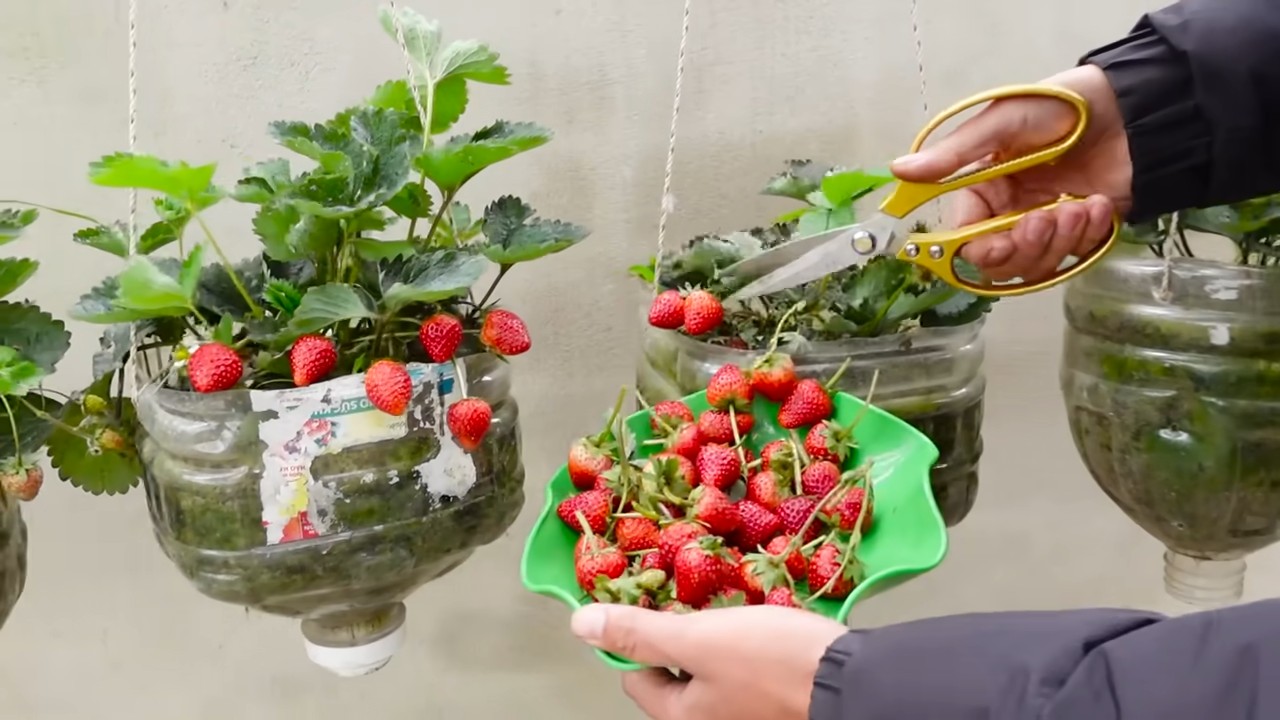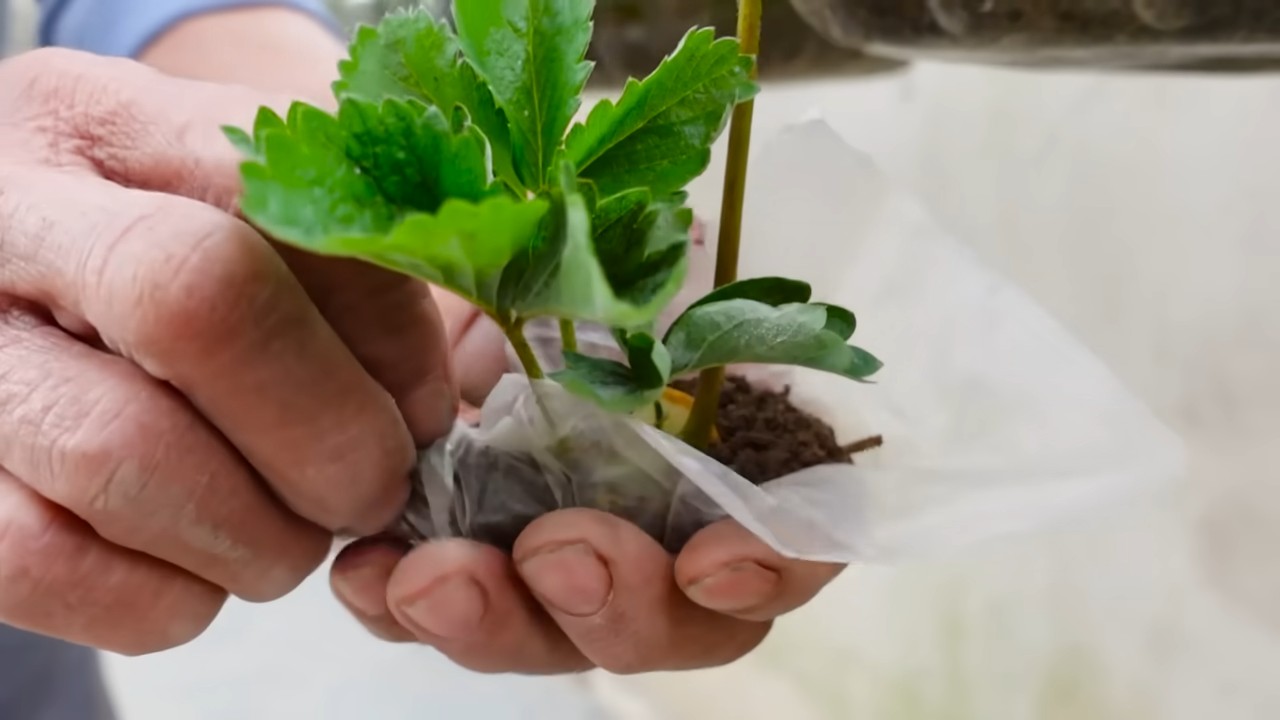Indoor Strawberry Growing – sounds like a dream, right? Imagine plucking juicy, red strawberries right from your kitchen, even in the dead of winter! Forget those bland, store-bought berries; we’re talking about homegrown sweetness bursting with flavor.
For centuries, humans have cultivated strawberries, with evidence suggesting their consumption dating back to ancient Rome. But the idea of bringing this outdoor delight indoors? That’s a more recent innovation, driven by our desire for fresh, local produce year-round. And let’s be honest, who wouldn’t want a little taste of summer sunshine brightening up their home?
In this article, I’m going to share some simple, yet effective DIY tricks and hacks that will transform your home into a mini strawberry farm. Whether you’re a seasoned gardener or a complete beginner, I’ll guide you through the process of indoor strawberry growing, from choosing the right varieties to troubleshooting common problems.
Why do you need these tricks? Because growing strawberries indoors can be tricky! Without the right knowledge, you might end up with leggy plants and disappointing harvests. But fear not! With these DIY solutions, you’ll be well on your way to enjoying a bountiful supply of delicious, homegrown strawberries, no matter the season. Let’s get started!

Grow Delicious Strawberries Indoors: A DIY Guide
Hey there, fellow plant enthusiasts! Ever dreamt of plucking fresh, juicy strawberries right from your kitchen? Well, dream no more! I’m going to walk you through a super fun and rewarding DIY project: growing strawberries indoors. It’s easier than you think, and the taste of homegrown berries is simply unbeatable. Let’s get started!
What You’ll Need
Before we dive in, let’s gather our supplies. Here’s a list of everything you’ll need to create your indoor strawberry paradise:
* Strawberry Plants: Opt for everbearing or day-neutral varieties. These types produce fruit throughout the growing season, unlike June-bearing varieties that produce one large crop. I recommend starting with at least 3-4 plants for a decent harvest.
* Pots or Containers: Choose pots that are at least 6-8 inches in diameter. Good drainage is crucial, so make sure your pots have drainage holes. Hanging baskets are also a fantastic option!
* Potting Mix: Use a high-quality potting mix specifically formulated for containers. Avoid using garden soil, as it can compact and hinder drainage.
* Grow Lights: Strawberries need a lot of light, so grow lights are essential for indoor growing, especially during the winter months. LED grow lights are energy-efficient and work great.
* Fertilizer: A balanced liquid fertilizer (10-10-10) will provide your plants with the nutrients they need to thrive.
* Watering Can or Spray Bottle: For gentle and even watering.
* Small Hand Trowel: For transplanting your strawberry plants.
* Scissors or Pruning Shears: For trimming runners and dead leaves.
* Optional: Strawberry supports or cages to keep the berries off the soil.
Choosing the Right Strawberry Variety
This is a crucial step! As I mentioned earlier, you’ll want to choose everbearing or day-neutral strawberry varieties for indoor growing. Here’s why:
* Everbearing Strawberries: These varieties produce two to three crops of strawberries throughout the growing season (spring, summer, and fall). They are a great choice for continuous harvesting. Some popular everbearing varieties include ‘Ozark Beauty,’ ‘Seascape,’ and ‘Albion.’
* Day-Neutral Strawberries: These varieties produce fruit continuously throughout the growing season, regardless of the day length. They are ideal for indoor growing because you can control the light exposure. Some popular day-neutral varieties include ‘Tristar,’ ‘Tribute,’ and ‘Mara des Bois.’
I personally love ‘Albion’ for its delicious flavor and consistent production. ‘Mara des Bois’ is another favorite because of its intense, almost wild strawberry flavor.
Planting Your Strawberries
Okay, now for the fun part! Let’s get those strawberry plants into their new homes.
1. Prepare Your Pots: Fill your pots with the potting mix, leaving about an inch of space at the top.
2. Remove Plants from Containers: Gently remove the strawberry plants from their original containers. If the roots are tightly packed, gently loosen them with your fingers.
3. Planting Depth: Place the strawberry plant in the center of the pot, making sure the crown (the point where the stems meet the roots) is level with the soil surface. Don’t bury the crown, as this can cause the plant to rot.
4. Fill with Soil: Fill in around the plant with more potting mix, gently pressing down to secure it.
5. Water Thoroughly: Water the newly planted strawberries thoroughly until water drains out of the drainage holes. This helps settle the soil and provides the plants with essential moisture.
Setting Up Your Indoor Strawberry Garden
Now that your strawberries are planted, it’s time to create the perfect indoor environment for them to thrive.
1. Light is Key: Place your strawberry plants under grow lights. Position the lights about 6-12 inches above the plants. I recommend using a timer to provide your plants with 12-16 hours of light per day. This will mimic the long days of summer and encourage fruit production.
2. Temperature: Strawberries prefer temperatures between 60-80°F (15-27°C). Avoid placing your plants near drafts or extreme temperature fluctuations.
3. Air Circulation: Good air circulation is essential to prevent fungal diseases. You can use a small fan to gently circulate the air around your plants.
4. Humidity: Strawberries prefer moderate humidity levels (around 50-60%). If your home is dry, you can increase humidity by placing a tray of water near your plants or using a humidifier.
Caring for Your Indoor Strawberry Plants
Consistent care is crucial for a bountiful harvest. Here’s what you need to do to keep your strawberry plants happy and healthy:
1. Watering: Water your strawberry plants regularly, keeping the soil consistently moist but not soggy. Check the soil moisture by sticking your finger into the soil. If the top inch feels dry, it’s time to water. Avoid overwatering, as this can lead to root rot.
2. Fertilizing: Fertilize your strawberry plants every 2-3 weeks with a balanced liquid fertilizer (10-10-10). Follow the instructions on the fertilizer label. During the flowering and fruiting stages, you can increase the frequency of fertilization to once a week.
3. Pollination: Indoor strawberries need help with pollination since there are no bees or other insects to do the job. You can hand-pollinate your plants by using a small paintbrush or cotton swab to gently transfer pollen from one flower to another. Alternatively, you can use a small fan to gently blow air around the plants, which will help distribute the pollen.
4. Pruning: Regularly prune your strawberry plants to remove dead or yellowing leaves. This will help improve air circulation and prevent diseases. Also, remove any runners (long stems that grow out from the plant) unless you want to propagate new plants. Runners divert energy from fruit production.
5. Pest Control: Keep an eye out for pests such as aphids, spider mites, and whiteflies. If you notice any pests, you can treat them with insecticidal soap or neem oil. Always follow the instructions on the product label.
Harvesting Your Strawberries
The moment you’ve been waiting for! Harvesting your homegrown strawberries is the most rewarding part of this project.
1. Ripeness: Strawberries are ready to harvest when they are fully red and slightly soft to the touch.
2. Harvesting Technique: Gently grasp the strawberry and twist it off the plant, leaving a small piece of the stem attached.
3. Enjoy! Enjoy your freshly harvested strawberries immediately, or store them in the refrigerator for a few days.
Troubleshooting Common Problems
Even with the best care, you might encounter some problems along the way. Here are some common issues and how to address them:
* Lack of Fruit: If your strawberry plants are not producing fruit, it could be due to insufficient light, improper pollination, or lack of nutrients. Make sure your plants are getting enough light, hand-pollinate them regularly, and fertilize them as needed.
* Yellowing Leaves: Yellowing leaves can be a sign of overwatering, underwatering, or nutrient deficiency. Check the soil moisture and adjust your watering schedule accordingly. Fertilize your plants with a balanced fertilizer.
* Root Rot: Root rot is caused by overwatering and poor drainage. Make sure your pots have drainage holes and avoid overwatering. If you suspect root rot, you can try transplanting your plant into fresh potting mix.
* Pests: As mentioned earlier, keep an eye out for pests and treat them with insecticidal soap or neem oil.
Propagating New Strawberry Plants
One of the coolest things about strawberries is that they’re super easy to propagate! You can create new plants from the runners that your existing plants produce. Here’s how:
1. Select a Runner: Choose a healthy runner with a small plantlet (a baby strawberry plant) growing at the end.
2. Rooting the Plantlet: Place the plantlet in a small pot filled with potting mix. You can use a paperclip or hairpin to hold the plantlet in place.
3. Watering: Water the plantlet regularly, keeping the soil moist.
4. Separation: Once the plantlet has developed roots (usually in a few weeks), you can cut the runner from the mother plant.
5. Transplanting: Transplant the new strawberry plant into a larger pot.
Extra Tips for Success
* Rotate Your Plants: Rotate your strawberry plants regularly to ensure even light exposure.
* Cleanliness: Keep your growing area clean to prevent diseases and pests.
* Patience: Growing strawberries indoors takes time and patience. Don’t get discouraged if you don’t see results immediately. With consistent care,

Conclusion
So, there you have it! Transforming your home into a miniature strawberry farm is not only achievable, but incredibly rewarding. We’ve walked you through the simple steps to successful indoor strawberry growing, proving that you don’t need acres of land or a perfect climate to enjoy the sweet taste of homegrown berries.
Why is this DIY trick a must-try? Because it brings the joy of gardening indoors, providing fresh, delicious strawberries right at your fingertips, regardless of the season. Imagine the satisfaction of plucking ripe, juicy berries from your own plants, knowing exactly where they came from and what went into growing them. It’s a healthier, more sustainable way to enjoy one of nature’s sweetest treats. Plus, it’s a fantastic conversation starter and a unique way to add a touch of green to your living space.
But the fun doesn’t stop there! Feel free to experiment with different strawberry varieties. Everbearing types are particularly well-suited for indoor growing, as they produce fruit throughout the season. You could also try different container sizes and materials. Terracotta pots offer excellent drainage, while hanging baskets can add a decorative element to your indoor garden.
Consider adding companion plants to your strawberry containers. Basil, thyme, and marigolds are known to deter pests and attract beneficial insects, creating a healthier environment for your strawberries. You can also adjust the nutrient solution to cater to the specific needs of your chosen strawberry variety. Some varieties may prefer a slightly more acidic or alkaline environment.
Don’t be afraid to get creative with your setup. If you have limited space, consider vertical gardening solutions like stacked planters or wall-mounted containers. You can even repurpose old items like plastic bottles or tin cans into charming strawberry planters. The possibilities are endless!
We understand that embarking on a new gardening adventure can be a little daunting, but we’re confident that with a little patience and attention, you’ll be enjoying a bountiful harvest of delicious strawberries in no time. Remember to provide your plants with plenty of light, water them regularly, and fertilize them as needed. Keep an eye out for pests and diseases, and address any issues promptly.
We truly believe that anyone can master the art of indoor strawberry growing. It’s a simple, affordable, and incredibly satisfying way to connect with nature and enjoy fresh, healthy food. So, what are you waiting for? Grab your supplies, follow our guide, and get ready to experience the joy of homegrown strawberries!
We’re eager to hear about your experiences with indoor strawberry growing! Share your photos, tips, and tricks in the comments below. Let’s create a community of indoor strawberry enthusiasts and inspire others to give it a try. We can all learn from each other and make our indoor strawberry gardens even more successful. Happy growing!
Frequently Asked Questions (FAQ)
What are the best strawberry varieties for indoor growing?
Everbearing strawberry varieties are generally the best choice for indoor growing because they produce fruit throughout the season, rather than just once a year. Some popular everbearing varieties include:
* Albion: Known for its large, flavorful berries and disease resistance.
* Seascape: A reliable producer with good flavor and adaptability.
* Tristan: A compact variety that’s well-suited for smaller containers.
* Ozark Beauty: Produces large, sweet berries and is relatively easy to grow.
* Mara des Bois: A French variety with a unique, intense flavor.
Day-neutral varieties are also a good option, as they are not affected by day length and will produce fruit as long as they have adequate light and temperature.
How much light do indoor strawberries need?
Strawberries need at least 6-8 hours of direct sunlight per day to thrive. If you don’t have a sunny window, you’ll need to supplement with artificial lighting. LED grow lights are a great option because they are energy-efficient and provide the full spectrum of light that plants need. Position the grow lights about 6-12 inches above the plants. You can use a timer to ensure that your strawberries get the right amount of light each day. Insufficient light will result in leggy plants and poor fruit production.
What kind of soil should I use for indoor strawberries?
Use a well-draining potting mix that is specifically formulated for containers. Avoid using garden soil, as it can become compacted and doesn’t drain well. A good potting mix will contain a blend of peat moss, perlite, and vermiculite. You can also add some compost to the mix to provide extra nutrients. Make sure the soil is slightly acidic, with a pH between 5.5 and 6.5. You can test the pH of your soil using a soil testing kit.
How often should I water my indoor strawberry plants?
Water your strawberry plants when the top inch of soil feels dry to the touch. Avoid overwatering, as this can lead to root rot. Water deeply, until the water drains out of the bottom of the pot. Be sure to empty the saucer underneath the pot to prevent the plants from sitting in water. The frequency of watering will depend on the temperature, humidity, and size of the pot. In general, you’ll need to water more often during the warmer months and less often during the cooler months.
How do I fertilize my indoor strawberry plants?
Fertilize your strawberry plants every 2-3 weeks with a balanced liquid fertilizer. Look for a fertilizer that is specifically formulated for strawberries or other fruiting plants. Follow the instructions on the fertilizer label carefully. Avoid over-fertilizing, as this can burn the roots. You can also add some slow-release fertilizer granules to the potting mix when you plant your strawberries. This will provide a steady supply of nutrients over time.
How do I pollinate my indoor strawberry plants?
Since there are no bees or other pollinators indoors, you’ll need to hand-pollinate your strawberry plants. Use a small paintbrush or cotton swab to gently transfer pollen from the stamen (the male part of the flower) to the pistil (the female part of the flower). Do this every day when the flowers are open. You can also use a small fan to circulate air around the plants, which can help to distribute the pollen.
How do I deal with pests and diseases on my indoor strawberry plants?
Inspect your strawberry plants regularly for pests and diseases. Common pests include aphids, spider mites, and whiteflies. You can control these pests by spraying the plants with insecticidal soap or neem oil. Diseases can be prevented by providing good air circulation and avoiding overwatering. If you notice any signs of disease, remove the affected leaves or plants immediately.
How long does it take for indoor strawberries to produce fruit?
It typically takes 2-3 months for indoor strawberries to produce fruit after planting. The exact time will depend on the variety of strawberry, the growing conditions, and the age of the plant. Be patient and continue to provide your plants with the care they need. You’ll be rewarded with delicious, homegrown strawberries in no time!
Can I grow strawberries indoors year-round?
Yes, you can grow strawberries indoors year-round if you provide them with the right conditions. This includes adequate light, water, nutrients, and temperature. You may need to adjust your care routine depending on the season. For example, you may need to provide more supplemental light during the winter months.
What is the ideal temperature for indoor strawberry growing?
The ideal temperature for indoor strawberry growing is between 60-80°F (15-27°C). Avoid exposing your plants to extreme temperatures, as this can stress them and reduce fruit production.




Leave a Comment